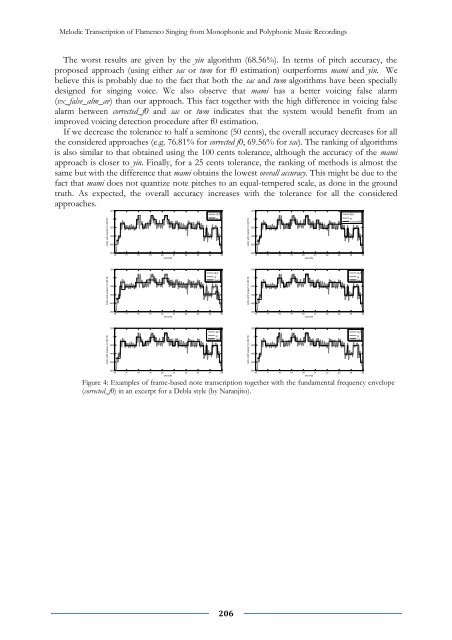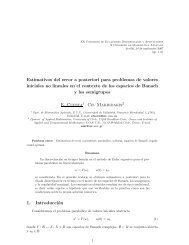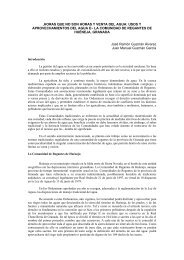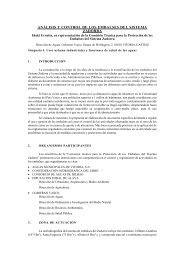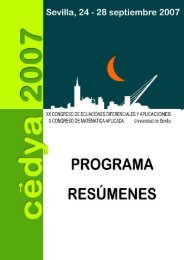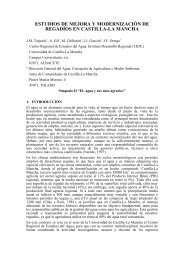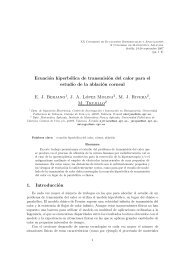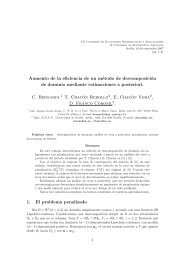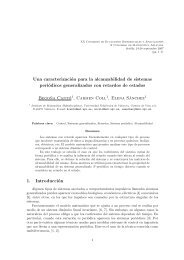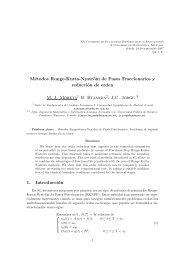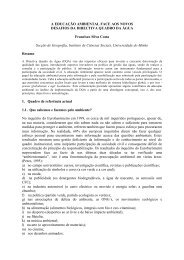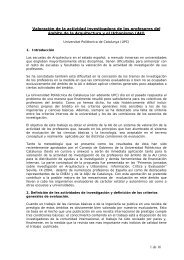LIBRO DE ACTAS (pdf) - Universidad de Sevilla
LIBRO DE ACTAS (pdf) - Universidad de Sevilla
LIBRO DE ACTAS (pdf) - Universidad de Sevilla
You also want an ePaper? Increase the reach of your titles
YUMPU automatically turns print PDFs into web optimized ePapers that Google loves.
Melodic Transcription of Flamenco Singing from Monophonic and Polyphonic Music Recordings<br />
The worst results are given by the yin algorithm (68.56%). In terms of pitch accuracy, the<br />
proposed approach (using either sac or twm for f0 estimation) outperforms mami and yin. We<br />
believe this is probably due to the fact that both the sac and twm algorithms have been specially<br />
<strong>de</strong>signed for singing voice. We also observe that mami has a better voicing false alarm<br />
(vx_false_alm_av) than our approach. This fact together with the high difference in voicing false<br />
alarm between corrected_f0 and sac or twm indicates that the system would benefit from an<br />
improved voicing <strong>de</strong>tection procedure after f0 estimation.<br />
If we <strong>de</strong>crease the tolerance to half a semitone (50 cents), the overall accuracy <strong>de</strong>creases for all<br />
the consi<strong>de</strong>red approaches (e.g. 76.81% for corrected f0, 69.56% for sac). The ranking of algorithms<br />
is also similar to that obtained using the 100 cents tolerance, although the accuracy of the mami<br />
approach is closer to yin. Finally, for a 25 cents tolerance, the ranking of methods is almost the<br />
same but with the difference that mami obtains the lowest overall accuracy. This might be due to the<br />
fact that mami does not quantize note pitches to an equal-tempered scale, as done in the ground<br />
truth. As expected, the overall accuracy increases with the tolerance for all the consi<strong>de</strong>red<br />
approaches.<br />
cents with respect to 440 Hz<br />
cents with respect to 440 Hz<br />
cents with respect to 440 Hz<br />
200<br />
0<br />
-200<br />
-400<br />
-600<br />
-800<br />
16 17 18 19 20 21 22 23 24 25<br />
seconds<br />
200<br />
0<br />
-200<br />
-400<br />
-600<br />
-800<br />
16 17 18 19 20 21 22 23 24 25<br />
seconds<br />
200<br />
0<br />
-200<br />
-400<br />
-600<br />
-800<br />
16 17 18 19 20 21 22 23 24 25<br />
seconds<br />
gt f 0<br />
gt<br />
gt f 0<br />
gt<br />
mami<br />
gt f 0<br />
gt<br />
twm<br />
206<br />
cents with respect to 440 Hz<br />
cents with respect to 440 Hz<br />
cents with respect to 440 Hz<br />
200<br />
0<br />
-200<br />
-400<br />
-600<br />
-800<br />
16 17 18 19 20 21 22 23 24 25<br />
seconds<br />
200<br />
0<br />
-200<br />
-400<br />
-600<br />
-800<br />
16 17 18 19 20 21 22 23 24 25<br />
seconds<br />
200<br />
0<br />
-200<br />
-400<br />
-600<br />
-800<br />
16 17 18 19 20 21 22 23 24 25<br />
Figure 4: Examples of frame-based note transcription together with the fundamental frequency envelope<br />
(corrected_f0) in an excerpt for a Debla style (by Naranjito).<br />
seconds<br />
gt f 0<br />
gt<br />
correctedf0<br />
gt f 0<br />
gt<br />
sac<br />
gt f 0<br />
gt<br />
yin


